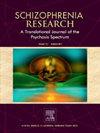早发性精神病的负担:诊断复杂性、高合并症和患者及其亲属的功能不良
IF 3.5
2区 医学
Q1 PSYCHIATRY
引用次数: 0
摘要
墨西哥(EPIMex)和波士顿(EPICenter)的早期精神病调查中心招募了患有早发性精神病(EOP)的儿童和青少年、他们的亲属和对照组,以阐明EOP的危险因素。方法在墨西哥收集860例EOP先证者、493例亲属和865例对照,在波士顿收集120例EOP先证者、182例亲属和60例对照。使用DSM-V (SCID-5)的结构化临床访谈来确定精神病学诊断。采用7项认知测验计算一般认知能力。分别用儿童整体评估量表或整体功能评估量表和简短精神病学评定量表来确定功能和症状。EOP先证者,有和没有诊断的亲属,以及有非精神病性诊断的对照组与没有诊断的对照组进行比较。结果在墨西哥,超过86%的EOP先证者至少有一种精神合并症,73%的亲属有精神疾病诊断,52%有多种诊断。在波士顿,77%的EOP先证者至少有一种精神疾病共病,80%的亲属有精神疾病诊断,42%有多种诊断。在墨西哥,EOP先证者和亲属表现出较小的认知缺陷(效应量(ES) = 0.22-0.29, p < 0.05)。在波士顿,所有组都表现出严重的认知缺陷(ES = 0.82-1.28, p = .001)。在这两个试验点,所有诊断组(EOP先证者、亲属和有诊断的对照组)都表现出较差的功能(ES = 0.87-1.92, p < 0.001)和严重的症状(ES = 0.52-1.71, p < 0.02),只有17%的EOP先证者表现出“良好”的功能(GAF/CGAS>70)。结论早发性精神病患者及其亲属存在较高的合并症和较差的功能。本文章由计算机程序翻译,如有差异,请以英文原文为准。
The burden of early onset psychosis: Diagnostic complexity, high comorbidity, and poor functioning in patients and their relatives
Background
The Early Psychosis Investigation Centers in Mexico (EPIMex) and Boston (EPICenter) recruit children and adolescents with early onset psychosis (EOP), their relatives, and controls to elucidate risk factors for EOP.
Methods
In Mexico, data were available for 860 EOP probands, 493 relatives, and 865 controls, and in Boston, for 120 EOP probands, 182 relatives, and 60 controls. Psychiatric diagnoses were ascertained using the Structured Clinical Interview for the DSM-V (SCID-5). General cognitive ability was calculated using 7 cognitive tests. Functioning and symptoms were ascertained with the Children's Global Assessment Scale or Global Assessment of Functioning scale, and the Brief Psychiatric Rating Scale, respectively. EOP probands, relatives with and without diagnoses, and controls with nonpsychotic diagnoses were compared to controls without diagnoses.
Results
In Mexico, over 86 % of EOP probands had at least one psychiatric comorbidity, and 73 % of relatives had a psychiatric diagnosis, with 52 % having multiple diagnoses. In Boston, 77 % of EOP probands had at least one psychiatric comorbidity, and 80 % of relatives had a psychiatric diagnosis, with 42 % having multiple diagnoses. In Mexico, EOP probands, and relatives showed small cognitive deficits (effect size (ES) = 0.22–0.29, p < .05). In Boston, all groups showed large cognitive deficits (ES = 0.82–1.28, p = .001). Across both sites, all diagnostic groups (EOP probands, relatives and controls with diagnoses) showed poor functioning (ES = 0.87–1.92, p < .001), and severe symptoms (ES = 0.52–1.71, p < .02), and only 17 % of EOP probands showed “good” functioning (GAF/CGAS>70).
Conclusions
Early onset psychosis (EOP) is associated with high comorbidity, and poor functioning in patients, and their relatives.
求助全文
通过发布文献求助,成功后即可免费获取论文全文。
去求助
来源期刊

Schizophrenia Research
医学-精神病学
CiteScore
7.50
自引率
8.90%
发文量
429
审稿时长
10.2 weeks
期刊介绍:
As official journal of the Schizophrenia International Research Society (SIRS) Schizophrenia Research is THE journal of choice for international researchers and clinicians to share their work with the global schizophrenia research community. More than 6000 institutes have online or print (or both) access to this journal - the largest specialist journal in the field, with the largest readership!
Schizophrenia Research''s time to first decision is as fast as 6 weeks and its publishing speed is as fast as 4 weeks until online publication (corrected proof/Article in Press) after acceptance and 14 weeks from acceptance until publication in a printed issue.
The journal publishes novel papers that really contribute to understanding the biology and treatment of schizophrenic disorders; Schizophrenia Research brings together biological, clinical and psychological research in order to stimulate the synthesis of findings from all disciplines involved in improving patient outcomes in schizophrenia.
 求助内容:
求助内容: 应助结果提醒方式:
应助结果提醒方式:


